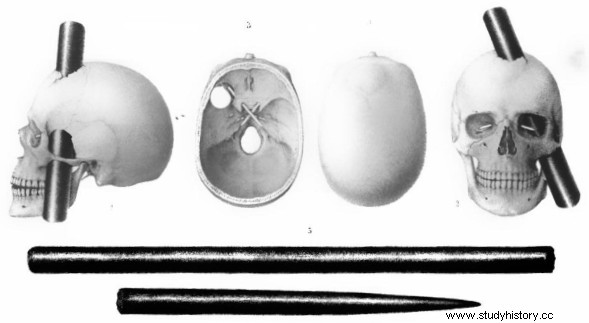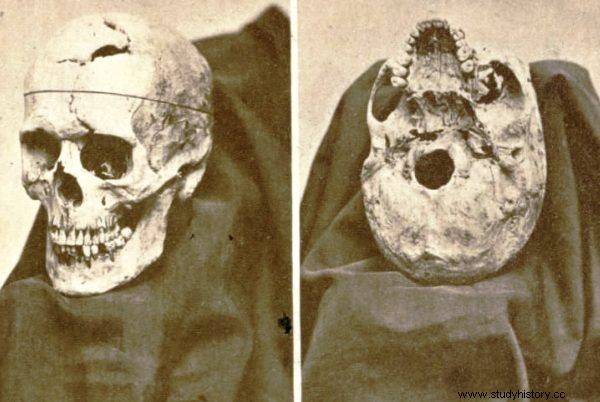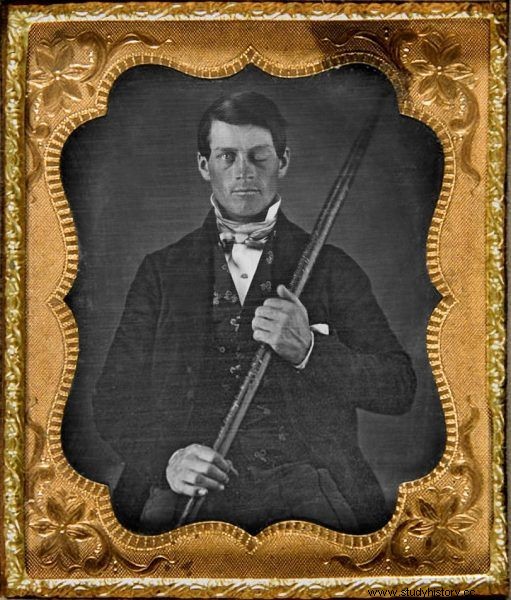A macabre accident, an unbelievable twist of fate and ordinary bad luck - sometimes scientists learn about the functioning of the human body in a very unconventional way. This was the case with Phineas Gage who lost some personality along with a fragment of his brain ...
Today it is known that an area of the brain called the prefrontal cortex is responsible for planning actions and predicting their consequences. At the same time, is a kind of "safety" that inhibits impulsive behavior originating in the hypothalamus and limbic system responsible for the basic functions of the organism. But it wasn't always that obvious.
To conclude that the brain is involved in personality formation at all, and that its damage can affect the behavior of the owner, scientists first had to see an example in vivo . And although similar cases had been previously described (even in ancient texts), it was not until the 19th century that a properly documented medical miracle happened that put science on the right track. Joseph Le Doux in his latest book The History of Our Consciousness writes:
Although the cortex of the brain is part of our shared heritage as mammals, its human version has unique characteristics that distinguish it from analogous structures in other mammals, including apes and other primates . By analyzing it, we can better understand a person's unique cognitive abilities. The prefrontal area is the most prominent cortical area. The area first gained notoriety thanks to the incident of Phineas Gage.

The rod pierced the skull right through and damaged the brain. It's a miracle the man survived
What was it that made this particular accident so profoundly influencing the knowledge and way in which science perceives the prefrontal cortex?
Unlucky Thirteen
September 13, 1848 turned out to be extremely unlucky for Phineas Gage. The man worked as a railroad foreman near Cavendish (Vermont, USA). To remove rocks, charges of gunpowder were used there, placed in specially drilled holes. Before being set on fire, the explosive was covered with sand, clay or other material and compacted with a special rod.
According to the art, only the fuse should protrude from the protected hole in the rock ... This time, however, it had to be different. Probably Gage forgot to cover the gunpowder load. Why - we will never find out. We do know how tragic the consequences of his mistake were.
The foreman was just turning to face the other staff when there was an unexpected outburst. It is speculated that it was caused by a spark caused by the friction of the rod against the rock. The rammer - a piece of metal 32 millimeters in diameter and weighing about 6 kilograms - fired like a bullet from a blast-hole, piercing Gage's skull through, and then flew several tens of meters.

The text is based on the book by Joseph LeDoux "The History of Our Consciousness", which has just been published by the Copernicus Center Press.
The man's head took a rather unusual angle. The bar bit into his upper jaw and shattered his cheekbone. Then it passed behind the eye, across the left side of the brain, and out, shattering the frontal bone of the skull . It had to be clear to the observers that Gage had no chance of survival.A guy with a hole in his head comes to the doctor
To say that Gage was lucky would be a considerable understatement. He was probably one of the lucky ones in the world. The typical rammer used to break rock had a curve (similar to a crowbar). But the "model" used by the foreman was unique:simple, custom-made at a nearby blacksmith. As a result, after the hit, only a hole was created in the man's skull, and most of his head remained intact.
Phineas Gage recovered after a short while and - with a little help - walked over to the train cart that transported him to a nearby town. After about 30 minutes, he met with the doctor, Edward H. Williams. The medic was shocked when the man with the hole in his head told him about the course of his accident. He then vomited, and as he bent down, "about half a cup of brain tissue" fell out of the opening at the top of his head (according to Williams' notes). According to the doctor's account, despite his terrible injuries and severe bleeding, Gage remained awake and endured the suffering heroically.
The patient was soon taken over by Dr. John Martyn Harlow. He shaved the area around the exit wound, removed the remains of clotted blood, bone fragments, and detached brain, and then sealed the wound with two strips, leaving a drainage hole. Later he applied a wet compress to Gage's head, put on a cap and finally a bandage to stabilize the dressing. He instructed the man, while he was recovering, to try to keep his head high above the rest of his body.

Skull of Gage with a visible hole made by a rod.
The foreman was recovering slowly and with numerous episodes. Sometimes he fell into a state similar to delirium, sometimes he did not recognize his relatives. After 10 weeks, he returned to his family in Lebanon. In February of the following year, he started doing simple work on the farm.
Unable to return to railroad construction, he spent some time as a "living exhibit" at the Barnum Museum in New York, and later took a job as a six-horse stagecoach driver in Chile on the Valparaiso-Santiago route. In 1859 he began to fall ill; he had seizures of epilepsy, which forced him to stop work again. He tried to take another one, but it didn't last long anywhere. He eventually returned to his family home, where he died on May 21, 1860, in another attack.
Same but different
Determining how much and in what exactly Phineas Gage's personality changed is very difficult today - mainly due to the fact that little evidence of what kind of human he was before the accident has been preserved. It is known, however, that the rod passing through his head left a permanent mark. " As a result of this accident, Gage's ability to reason and make decisions was significantly impaired ”- he writes in The History of Our Consciousness Joseph Le Doux.
The little information about Gage from before the unlucky day shows that he was a hardworking, responsible man and liked by his colleagues. Meanwhile, according to the descriptions prepared by Dr. Harlow, after the accident the former foreman became a seemingly completely different person - as if the balance between his intellect and primitive urges and reflexes had been disturbed ...
In place of a reasonable, sober-minded man who consistently implemented his plans, another appeared, constantly creating new visions of the future, but impulsive and never implementing them. He changed so much that some of his friends and relatives no longer consider him the same person.

Daguerreotype of Gage after the accident
Even more interestingly, later descriptions of Gage - for example, an 1860 account of him, compiled by an American physician based on observations from 1858–59 - drew a very different picture of him from Harlow's early accounts. It's as if Gage had regained some of his lost social abilities. In addition, the job of a stagecoach driver he undertook required not only good motor coordination (he led a team of six horses on his own!) But also maintaining friendly contacts with customers!
Miracle or routine?
The case of Phineas Gage proved not only that the prefrontal cortex is responsible for specific mental functions, but also that its damage can regenerate over time. In The History of Our Consciousness Joseph LeDoux reports:
Later, in the 20th century, the Russian psychologist Alexander Luria, on the basis of observations of the behavior of World War II veterans with head injuries, confirmed that damage to the prefrontal areas leads to deficits in attention, thinking and planning.
With the advent of the cognitive revolution, this range of mental faculties has been linked to working memory. Indeed, studies of working memory in humans and monkeys indicated that the prefrontal cortex contributed to the fusion of information, the short-term storage of representations, and their use in the control of thinking and acting.
It is very likely that Gage's relentless efforts to live and work actively helped him regain his lost abilities. As a stagecoach driver, the patient performed repetitive, moderately focused jobs, gradually extended with new tasks (similar injuries are treated similarly today).
Phineas prepared himself for hygiene every morning, then looked after the horses - fed and harnessed them - arrived at the pickup point at the appointed time, loaded the luggage and chatted with the passengers. Perhaps he also used methods used today, such as visualizing a list of activities to be performed in the mind. In addition, the work of a stagecoach driver on a route measuring approximately 160 kilometers required planning - both the entire 13-hour route and every turn:a six-horse team is not easy to drive!
Over time, the story of Phineas Gage was surrounded by a garland of imaginary and exaggerated information. Many authors attributed to him traits that he never actually exhibited, such as an acquired tendency to gamble or violence. In addition, in the last months of life, the escalating seizures of epilepsy may have seemed to outside observers that they returned to the unpleasant state immediately after the accident.
In the medical community, the foreman's history quickly became a comparative measure, as it was the only well-documented case of brain damage in a living patient at the time, and one of the first documented cases to prove the relationship between the prefrontal cortex and human personality.
Source:
The text is based on the latest book by Joseph LeDoux, The History of Our Consciousness , which has just been released by Copernicus Center Press.
